Maria Liakata
Enhancing Logical Reasoning in Language Models via Symbolically-Guided Monte Carlo Process Supervision
May 26, 2025Abstract:Large language models (LLMs) have shown promising performance in mathematical and logical reasoning benchmarks. However, recent studies have pointed to memorization, rather than generalization, as one of the leading causes for such performance. LLMs, in fact, are susceptible to content variations, demonstrating a lack of robust symbolic abstractions supporting their reasoning process. To improve reliability, many attempts have been made to combine LLMs with symbolic methods. Nevertheless, existing approaches fail to effectively leverage symbolic representations due to the challenges involved in developing reliable and scalable verification mechanisms. In this paper, we propose to overcome such limitations by generating symbolic reasoning trajectories and select the high-quality ones using a process reward model automatically tuned based on Monte Carlo estimation. The trajectories are then employed via fine-tuning methods to improve logical reasoning and generalization. Our results on logical reasoning benchmarks such as FOLIO and LogicAsker show the effectiveness of the proposed method with large gains on frontier and open-weight models. Moreover, additional experiments on claim verification reveal that fine-tuning on the generated symbolic reasoning trajectories enhances out-of-domain generalizability, suggesting the potential impact of symbolically-guided process supervision in alleviating the effect of memorization on LLM reasoning.
Temporal reasoning for timeline summarisation in social media
Dec 30, 2024



Abstract:This paper explores whether enhancing temporal reasoning capabilities in Large Language Models (LLMs) can improve the quality of timeline summarization, the task of summarising long texts containing sequences of events, particularly social media threads . We introduce \textit{NarrativeReason}, a novel dataset focused on temporal relationships among sequential events within narratives, distinguishing it from existing temporal reasoning datasets that primarily address pair-wise event relationships. Our approach then combines temporal reasoning with timeline summarization through a knowledge distillation framework, where we first fine-tune a teacher model on temporal reasoning tasks and then distill this knowledge into a student model while simultaneously training it for the task of timeline summarization. Experimental results demonstrate that our model achieves superior performance on mental health-related timeline summarization tasks, which involve long social media threads with repetitions of events and a mix of emotions, highlighting the importance of leveraging temporal reasoning to improve timeline summarisation.
TempoFormer: A Transformer for Temporally-aware Representations in Change Detection
Aug 28, 2024



Abstract:Dynamic representation learning plays a pivotal role in understanding the evolution of linguistic content over time. On this front both context and time dynamics as well as their interplay are of prime importance. Current approaches model context via pre-trained representations, which are typically temporally agnostic. Previous work on modeling context and temporal dynamics has used recurrent methods, which are slow and prone to overfitting. Here we introduce TempoFormer, the fist task-agnostic transformer-based and temporally-aware model for dynamic representation learning. Our approach is jointly trained on inter and intra context dynamics and introduces a novel temporal variation of rotary positional embeddings. The architecture is flexible and can be used as the temporal representation foundation of other models or applied to different transformer-based architectures. We show new SOTA performance on three different real-time change detection tasks.
Feedback-aligned Mixed LLMs for Machine Language-Molecule Translation
May 22, 2024Abstract:The intersection of chemistry and Artificial Intelligence (AI) is an active area of research focused on accelerating scientific discovery. While using large language models (LLMs) with scientific modalities has shown potential, there are significant challenges to address, such as improving training efficiency and dealing with the out-of-distribution problem. Focussing on the task of automated language-molecule translation, we are the first to use state-of-the art (SOTA) human-centric optimisation algorithms in the cross-modal setting, successfully aligning cross-language-molecule modals. We empirically show that we can augment the capabilities of scientific LLMs without the need for extensive data or large models. We conduct experiments using only 10% of the available data to mitigate memorisation effects associated with training large models on extensive datasets. We achieve significant performance gains, surpassing the best benchmark model trained on extensive in-distribution data by a large margin and reach new SOTA levels. Additionally we are the first to propose employing non-linear fusion for mixing cross-modal LLMs which further boosts performance gains without increasing training costs or data needs. Finally, we introduce a fine-grained, domain-agnostic evaluation method to assess hallucination in LLMs and promote responsible use.
Assessing the Reasoning Abilities of ChatGPT in the Context of Claim Verification
Feb 16, 2024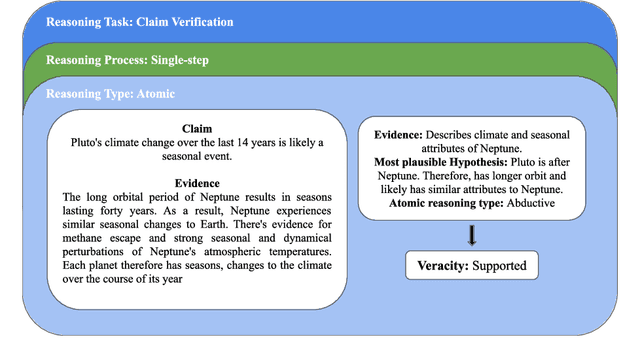
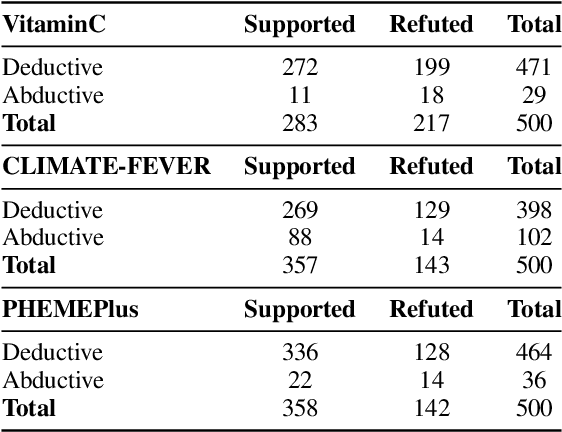
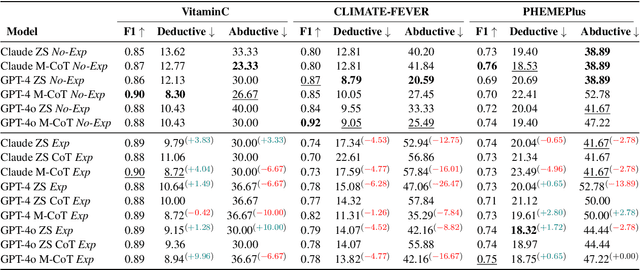

Abstract:The reasoning capabilities of LLMs are currently hotly debated. We examine the issue from the perspective of claim/rumour verification. We propose the first logical reasoning framework designed to break down any claim or rumor paired with evidence into the atomic reasoning steps necessary for verification. Based on our framework, we curate two annotated collections of such claim/evidence pairs: a synthetic dataset from Wikipedia and a real-world set stemming from rumours circulating on Twitter. We use them to evaluate the reasoning capabilities of GPT-3.5-Turbo and GPT-4 (hereinafter referred to as ChatGPT) within the context of our framework, providing a thorough analysis. Our results show that ChatGPT struggles in abductive reasoning, although this can be somewhat mitigated by using manual Chain of Thought (CoT) as opposed to Zero Shot (ZS) and ZS CoT approaches. Our study contributes to the growing body of research suggesting that ChatGPT's reasoning processes are unlikely to mirror human-like reasoning, and that LLMs need to be more rigorously evaluated in order to distinguish between hype and actual capabilities, especially in high stake real-world tasks such as claim verification.
Clinically meaningful timeline summarisation in social media for mental health monitoring
Jan 29, 2024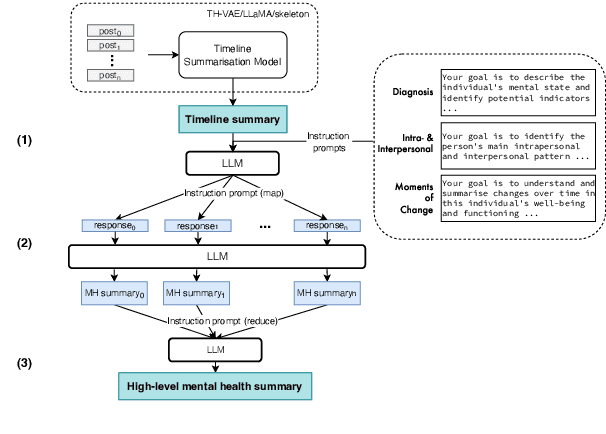
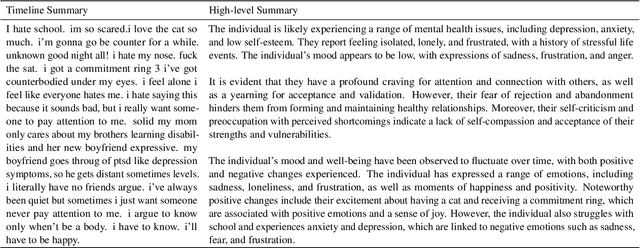
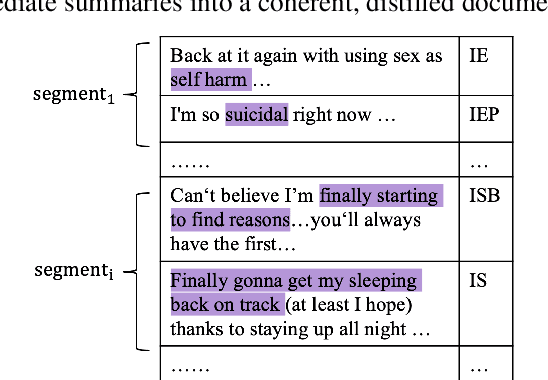
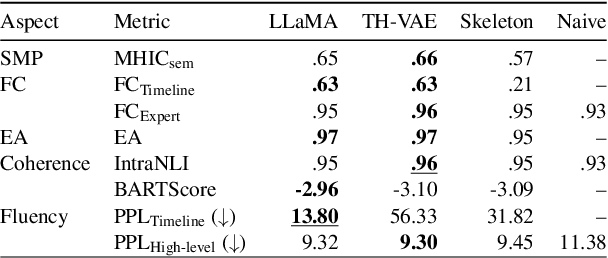
Abstract:We introduce the new task of clinically meaningful summarisation of social media user timelines, appropriate for mental health monitoring. We develop a novel approach for unsupervised abstractive summarisation that produces a two-layer summary consisting of both high-level information, covering aspects useful to clinical experts, as well as accompanying time sensitive evidence from a user's social media timeline. A key methodological novelty comes from the timeline summarisation component based on a version of hierarchical variational autoencoder (VAE) adapted to represent long texts and guided by LLM-annotated key phrases. The resulting timeline summary is input into a LLM (LLaMA-2) to produce the final summary containing both the high level information, obtained through instruction prompting, as well as corresponding evidence from the user's timeline. We assess the summaries generated by our novel architecture via automatic evaluation against expert written summaries and via human evaluation with clinical experts, showing that timeline summarisation by TH-VAE results in logically coherent summaries rich in clinical utility and superior to LLM-only approaches in capturing changes over time.
Generating Unsupervised Abstractive Explanations for Rumour Verification
Jan 23, 2024



Abstract:The task of rumour verification in social media concerns assessing the veracity of a claim on the basis of conversation threads that result from it. While previous work has focused on predicting a veracity label, here we reformulate the task to generate model-centric, free-text explanations of a rumour's veracity. We follow an unsupervised approach by first utilising post-hoc explainability methods to score the most important posts within a thread and then we use these posts to generate informative explanatory summaries by employing template-guided summarisation. To evaluate the informativeness of the explanatory summaries, we exploit the few-shot learning capabilities of a large language model (LLM). Our experiments show that LLMs can have similar agreement to humans in evaluating summaries. Importantly, we show that explanatory abstractive summaries are more informative and better reflect the predicted rumour veracity than just using the highest ranking posts in the thread.
Sig-Networks Toolkit: Signature Networks for Longitudinal Language Modelling
Dec 06, 2023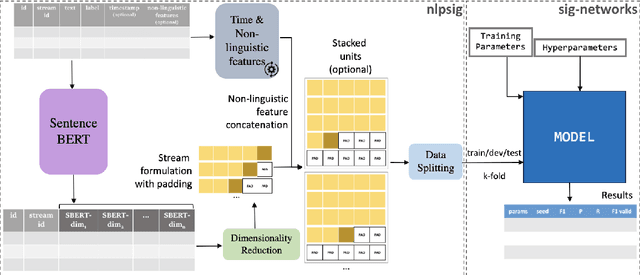
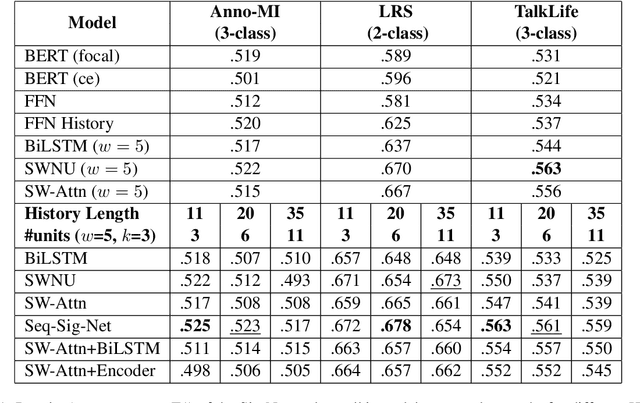
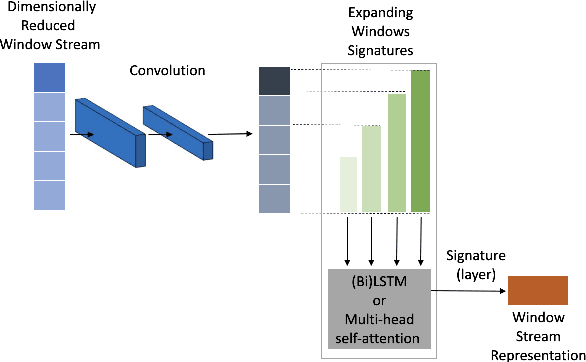
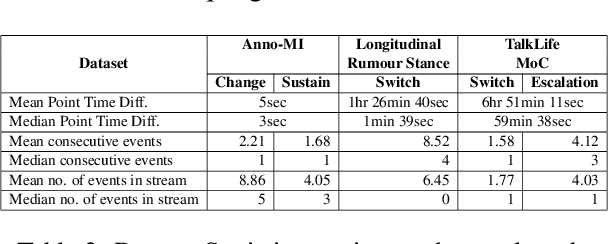
Abstract:We present an open-source, pip installable toolkit, Sig-Networks, the first of its kind for longitudinal language modelling. A central focus is the incorporation of Signature-based Neural Network models, which have recently shown success in temporal tasks. We apply and extend published research providing a full suite of signature-based models. Their components can be used as PyTorch building blocks in future architectures. Sig-Networks enables task-agnostic dataset plug-in, seamless pre-processing for sequential data, parameter flexibility, automated tuning across a range of models. We examine signature networks under three different NLP tasks of varying temporal granularity: counselling conversations, rumour stance switch and mood changes in social media threads, showing SOTA performance in all three, and provide guidance for future tasks. We release the Toolkit as a PyTorch package with an introductory video, Git repositories for preprocessing and modelling including sample notebooks on the modeled NLP tasks.
Reformulating NLP tasks to Capture Longitudinal Manifestation of Language Disorders in People with Dementia
Oct 15, 2023



Abstract:Dementia is associated with language disorders which impede communication. Here, we automatically learn linguistic disorder patterns by making use of a moderately-sized pre-trained language model and forcing it to focus on reformulated natural language processing (NLP) tasks and associated linguistic patterns. Our experiments show that NLP tasks that encapsulate contextual information and enhance the gradient signal with linguistic patterns benefit performance. We then use the probability estimates from the best model to construct digital linguistic markers measuring the overall quality in communication and the intensity of a variety of language disorders. We investigate how the digital markers characterize dementia speech from a longitudinal perspective. We find that our proposed communication marker is able to robustly and reliably characterize the language of people with dementia, outperforming existing linguistic approaches; and shows external validity via significant correlation with clinical markers of behaviour. Finally, our proposed linguistic disorder markers provide useful insights into gradual language impairment associated with disease progression.
A Digital Language Coherence Marker for Monitoring Dementia
Oct 14, 2023Abstract:The use of spontaneous language to derive appropriate digital markers has become an emergent, promising and non-intrusive method to diagnose and monitor dementia. Here we propose methods to capture language coherence as a cost-effective, human-interpretable digital marker for monitoring cognitive changes in people with dementia. We introduce a novel task to learn the temporal logical consistency of utterances in short transcribed narratives and investigate a range of neural approaches. We compare such language coherence patterns between people with dementia and healthy controls and conduct a longitudinal evaluation against three clinical bio-markers to investigate the reliability of our proposed digital coherence marker. The coherence marker shows a significant difference between people with mild cognitive impairment, those with Alzheimer's Disease and healthy controls. Moreover our analysis shows high association between the coherence marker and the clinical bio-markers as well as generalisability potential to other related conditions.
 Add to Chrome
Add to Chrome Add to Firefox
Add to Firefox Add to Edge
Add to Edge